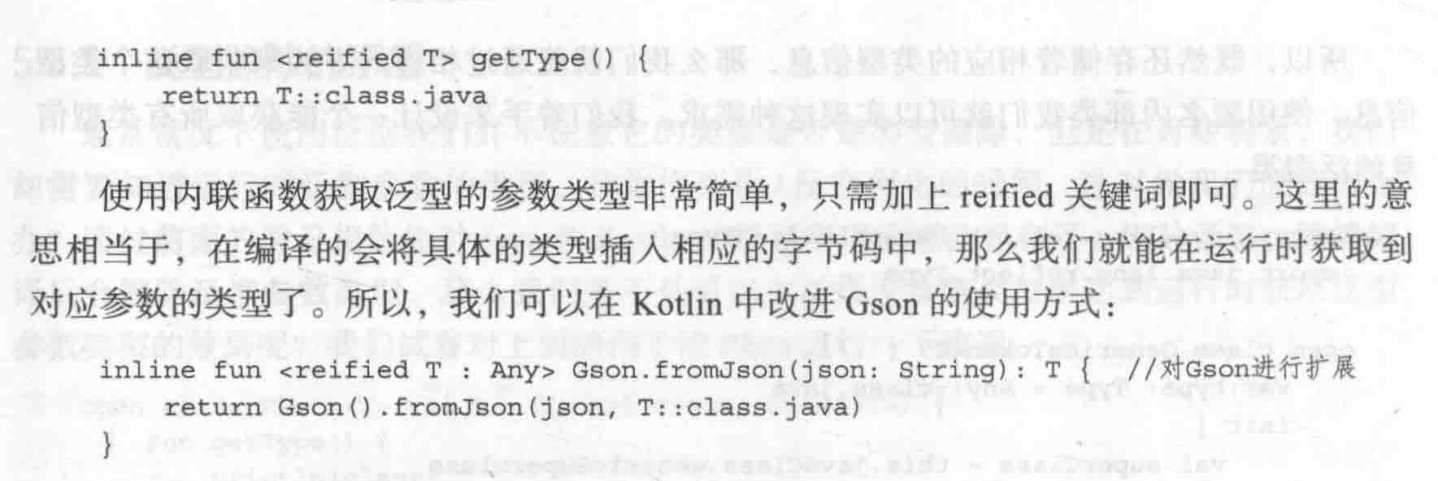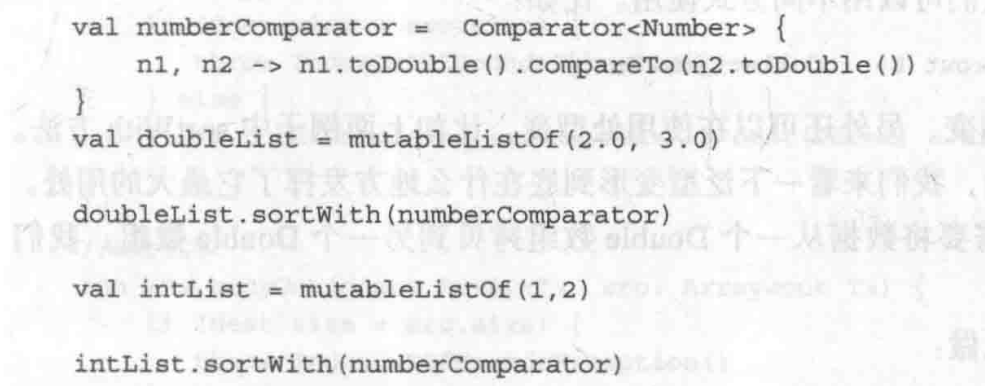文章目录
1. 基本概念
1.1 泛型的作用
- 编译时可以检查出错误
- 运行时可以自动进行类型转换
1.2 泛型的使用
- fun find(t: T): T?{}
- fun ArrayList.find (t: T): T? {}
1.3 where关键字
当一个类型参数指定多个约束时,在 Java 中使用&连接多个类、接口。
classClassA { }
interface InterfaceB { }
public class MyClass<T extends ClassA & InterfaceB> {
Class<T> variable;
}
Kotlin使用where关键字
open class ClassA
interface InterfaceB
class MyClass<T>(var variable: Class<T>) where T : ClassA, T : InterfaceB
2. 理解泛型擦除
2.1 基本理解
- 泛型信息仅在编译时用于类型检查
- 泛型参数在运行时不保留
- 泛型参数被替换为上界(如 Any?)
2.2 为什么引入泛型擦除
解决Java中向后兼容的问题,即老版本的代码可以在新版本的jvm上运行。比如ArrayList list = new ArrayList()
2.3 泛型擦除的矛盾
- 比如在序列化或者反序列化场景下需要知道运行时泛型参数的类型
2.4 内联函数获取泛型

3. 不变,协变,逆变
3.1 不变
- 在Java中List< String > 不能赋值给List< Object >
- Kotlin允许,多了一个关键字out

- Java和Kotlin中List的定义

3.2 协变
1. 基础定义
- 如果 A 是 B 的子类型,并且Generic< A> 也是 Generic< B > 的子类型,那么 Generic 可以称之为一个协变类。
- 需要在泛型参数前面加上 out 关键字
- 无法添加元素,只能读取内容(没有add方法)
- UnsafeVariance 在协变(Covariance)中的应用主要是用于打破 Kotlin编译器对泛型类型参数使用位置的限制,从而允许将协变类型参数(out T)用在一些原本不允许的位置(如函数参数、可变属性等),前提是开发者自己能保证类型安全。
2. 案例分析:接口类List
前提是List类使用了out关键字定义泛型参数类型;
String是Any的子类,因此List< String >是List< Any >的子类
val stringList : List<String> = ArrayList<String>()
val anyList : List<Any> = stringList
//假设有add方法
anyList.add(1)
val str: String = anyList.get(0) //出错
- List源码
- 使用了out关键字声明
- 没有add方法
- UnsafeVariance的使用,如何理解大白话讲,比如contains中E被当作输入参数(所谓的逆变点),因此就需要加上该注解
public interface List<out E> : Collection<E> {
// Query Operations
override val size: Int
override fun isEmpty(): Boolean
override fun contains(element: @UnsafeVariance E): Boolean
override fun iterator(): Iterator<E>
// Bulk Operations
override fun containsAll(elements: Collection<@UnsafeVariance E>): Boolean
// Positional Access Operations
/**
* Returns the element at the specified index in the list.
*/
public operator fun get(index: Int): E
// Search Operations
/**
* Returns the index of the first occurrence of the specified element in the list, or -1 if the specified
* element is not contained in the list.
*/
public fun indexOf(element: @UnsafeVariance E): Int
/**
* Returns the index of the last occurrence of the specified element in the list, or -1 if the specified
* element is not contained in the list.
*/
public fun lastIndexOf(element: @UnsafeVariance E): Int
// List Iterators
/**
* Returns a list iterator over the elements in this list (in proper sequence).
*/
public fun listIterator(): ListIterator<E>
/**
* Returns a list iterator over the elements in this list (in proper sequence), starting at the specified [index].
*/
public fun listIterator(index: Int): ListIterator<E>
// View
/**
* Returns a view of the portion of this list between the specified [fromIndex] (inclusive) and [toIndex] (exclusive).
* The returned list is backed by this list, so non-structural changes in the returned list are reflected in this list, and vice-versa.
*
* Structural changes in the base list make the behavior of the view undefined.
*/
public fun subList(fromIndex: Int, toIndex: Int): List<E>
}
3.3 逆变
1. 基础定义
-
如果 A 是 B 的子类型,并且Generic< B> 反过来是 Generic< A > 的子类型,那么 Generic可以称之为一个逆变类。
-
in关键字不能作为方法的返回值类型,但可以作为方法的参数类型
-
等价于Java中的<? super T>
-
没有get方法
2. 案例分析


4. 星投影
星号投影用来表明“不知道关于泛型实参的任何信息”。
类似于 Java 中的无界类型通配符?, Kotlin 使用星号投影*。
*代指了所有类型,相当于Any?。
例如:MutableList<*> 表示的是 MutableList<out Any?>
fun main() {
val list1 = mutableListOf<String>()
list1.add("string1")
list1.add("string2")
printList(list1)
val list2 = mutableListOf<Int>()
list2.add(123)
list2.add(456)
printList(list2)
}
fun printList(list: MutableList<*>) {
println(list[0])
}
正是由于使用 out 修饰以及星号投影的类型不确定性,会导致写入的任何值都有可能跟原有的类型冲突。因此,星号投影不能写入,只能读取。






















 3184
3184

 被折叠的 条评论
为什么被折叠?
被折叠的 条评论
为什么被折叠?








